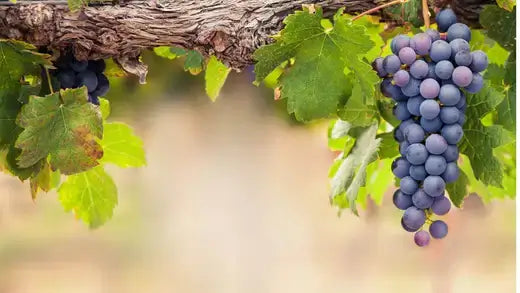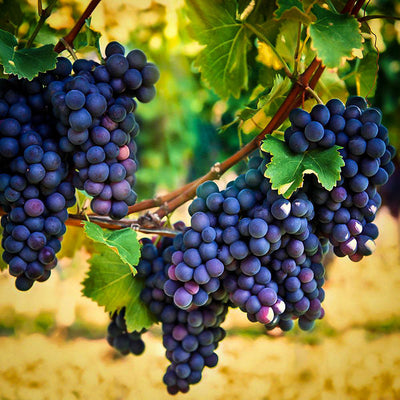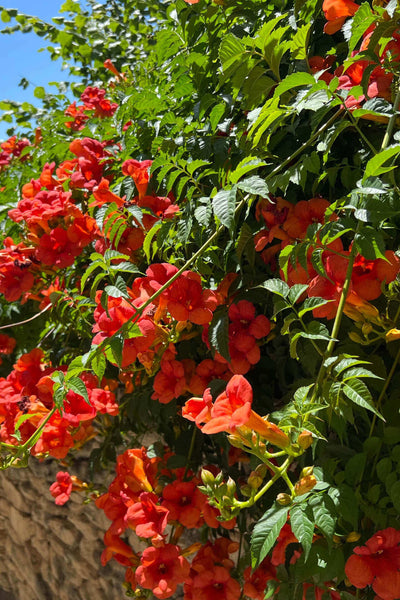The Sweetness of Grapes and Their Growth and Harvesting
Grapes are a wonderfully versatile fruit. Beyond their place in a fresh fruit salad, they are the main ingredient in a variety of foods, including sweet jams and world-class wines. If you've ever dreamed of walking through your own backyard and plucking a fresh, ripe bunch of grapes, this guide is for you. Winter is a time in which we can plan our future vineyard, no matter how small it is.

A history of grapes in America
The earliest settlers in the New World first came across grapes that grew wild along streams and in wooded areas. These native species are hardy and resilient. Over the years, these native vines were crossed with vines from Europe, resulting in hybrid plants that contain the tough qualities of American grapes, and the high quality and better taste of European grapes. Because of this history, today we have many different varieties of these grapes that are delicious and sturdy, drought resistant, and can survive in poorer soils. With the right care, a grapevine can stay productive for a long time, 20 to 30 years.
Picking the Correct Grape Type
Many different types of grapes let you grow your own grapes based on color, flavor, shape, ripening times, and food uses. Also, some grapes are better for certain things, like making your own wine, fresh juice, or eating healthy. Varieties of grapes you could grow are concord grapes for their classic deep purple skin and flavor, seedless green thompson grapes, and cabernet sauvignon for making wine. Always selecting and buying disease resistant grapes also helps for less future work and better overall crop in the end.
Determining Where To Plant
Grapes grow very well in the sun, so it is better to pick out a sun spot for their location that will be warm. A good location to plant is one that will receive full sun most of the day. Draining room is also a must, so let your grapes be somewhere higher rather than lower at your site. In some places especially in the rocks and in deserts the soil will be bad, grape roots will be better for places with a more full soil with a lot of organic matter.
The best time to do your planting is late winter or early spring. This is an important time for bare-root plants to get a start on developing a strong root system to replenish the nutrition that is vital for growing the lost roots before the heat of summer comes.
Deciding on a Site and Variety to Plant Your Grapevines
After you do choose your site and variety, the next step is to do the planting. One-year-old, vigorous growing plants are often the best selection. Although two-year-old plants are available to purchase, they tend to be more on the expensive side with no more success with growing than the younger ones. The best route to take in sourcing your stock comes from sellers that do not specialize in farming, as they are more likely to have plants that are not diseased.
When the time comes for planting, take the vines and sink them into the soil to the same depth as their nursery containers and then space them on the row by 5 to 8 feet at a time. Careful for the roots, spread them out evenly to form a circle so they will grow outwards. Trim roots that are long and broken, so they will grow out stably.
Once roots are arranged, spread the roots out and cover them along with the rest of the hole with soil, tamping it down to fill all the gaps and create a good space for soil to come in contact with the roots and to create a good rooting space. Once an equilibrium has been reached, fill the cavity with the water. Once the water has been taken further fill the soil cavity to match the level of the rest of the ground.
After the vines are placed in the ground and as the buds are still resting, prune them so that they are down to a single cane. Once that step is done and only the single cane is left, prune that down to 2 or 3 short buds according to what is deemed strong. After that spend some time waiting for the buds to start to grow and of the new grouped buds that fit the criteria of strong and vigorous to then, tie the buds, which will start as the main trunk for the vine to, a stake for some support.
Training, Trellising, and Pruning
To have a successful, high-yield grape, vines need to be trained along a certain system and trellising needs to be done. A durable trellis, or grape holder, is a must along the growing and waiting process. A standard configuration is a double horizontal wire system, the upper wire sitting about six feet above the ground. In the first year, focus on training the primary trunk to grow straight up to touch the top wire.
In year two, you will work on the vines structural development. Two lateral shoots, or cordons, are selected for training to grow sideways, horizontally, along the top wires. Once these cordons are established, you systematically prune the vine in the shape of a balanced system to allow for the maximum volume of fruit. You do this by holding onto several fruiting spurs, small sections of two-five buds, along each cordon. These buds will form the shoots that bear the grape fruit. Although it sounds odd, you are supposed to prune the plants pretty heavily each year in the winter dormant season to ignite new, productive growth.
Grapes can also fill an area functionally and aesthetically. They can be trained to border and define a property or to give extra privacy to views. A fast growing, colorful planting combination with grapes can be the climbing Trumpet Vine and others which will create a vertical garden. Just be aware that time is required to get the best results with weeding, tying, pruning, and spraying.
Caring for Grapes
Grapes benefit from shallow cultivation to keep it weeded. Try to keep an area 4 feet or more weed free. You can use mulch to keep the weeds at bay, but also to keep the soil from drying and to make the area look good. Just don't use overly rich organics like fresh manure because it will make the vines grow too fast for good fruit.
The leaves get light, and the sugars produced in the leaves make the grapes sweet and tasty. Make sure the vines get full sun exposure to get the sweetest grapes.
Keeping the grapes from birds is hard. You can use covering netting over the vines when they are ripening, and you can stick small brown paper bags over the clusters to keep them safe.
How to Tell When Grapes are Ripe
You can tell grapes are ripe because they change color and have a natural bloom, which is a whitish coating on the skin. Inside the grape, the seeds change from bright green to a brown color to show the grape is ready to eat.
Other key signs of ripeness when harvesting include shrinkage and size of the grape; just as all other fruits, grapes do begin to shrivel as they ripen. However, the best overall indicator of ripeness is the taste of the grape itself. Many grapes should not be harvested until the vine has been completely taste tested, as grapes will not ripen any further after they are cut from the vine. Ripened grapes will store for approximately 8 weeks at 32 degrees Fahrenheit and 85% humidity. If you have an excess, feel free to make the jelly, jam, juice, or even wine!
Find Your Perfect Plants at TN Nursery
Want to start your very own vineyard? TN Nursery has you covered, from the popular Concord grape to other lovely climbing plants like the Trumpet Vine. With TN Nursery, you can make a productive and vibrant outdoor space. Healthy and robust, TN Nursery plants are a great choice for your outdoor space. Visit us to get your climbing plants and grapevines.
FAQs
How many bottles of wine will 1 acre of grapes produce?
On average, 1 acre of grapevines can yield 2 to 10 tons. Each acre of vines will produce anywhere between 1,200 and 6,000 bottles. This is determined based on the fruiting variety of the grapes. The grapes variety and the wine style can cause the vary in production.
What month are grapes usually harvested?
Grapes are usually harvested in the warmer months when the grapes have properly ripened. The larger climate surrounding the vineyard will determine when in the warmer months that the grapes can finally be harvested. In the northern hemisphere, the grape harvest usually takes place between the months of August and October.
What month should you plant grapes?
The best time to plant grapevines is early spring and in late winter. This allows the dead, dormant bare plants to properly establish roots in the cool moist soil before the soil warms up to the summer dry soil. This will help the grape vines get a good start to healthy summer growth.
Why are grapes harvested at night?
Wine grapes are meticulously harvested at night or during the early morning hours. Harvesting in the cool temperatures help to preserve the grapes' acidity and tender aromas. It also helps to slow the grapes' oxidation. Finally, it makes picking grapes more comfortable for the workers because it is cooler outside.
Do you cut grape vines back in the fall?
Yes, but grape vines are not cut back until after the fall. The best time to do this is in late winter or early spring, while the plant is dormant. The purpose of the pruning is to remove the old wood and to promote the growth of new canes and improve the plant's fruit for the next season.



